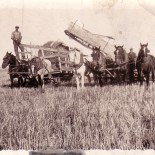Mystery of the Movable Glenannan General Store
Mystery of Galbraith’s Moving Store
In Glenannan, there existed a store run by a Mr. Galbraith, said to have begun its career on the north side of the road, but was moved across the road to tC11L14 after a disagreement. The store was part of a cluster of properties called the village of Glenannan. In addition to the store, it had a sawmill (tC10L13), a post office (tC10L13), a blacksmith shop (tC10L13) and a railroad stop (tC10L13) where mail was delivered, picked up and where passengers could catch the train. Up the road was schoolhouse (tC11L10) and a Primitive Methodist church (tC10L10), which later became a Temperance Lodge. When trying to pin down the story of the moving store, the following facts came to light.
In 1861, John (26) and Matilda (26) Galbraith lived in Turnberry Township with their two children, Robert (4) and William James (2) and a William Galbraith (21), possibly John’s younger brother. John and William were from Ireland and were of the Primitive Methodist faith. Matilda had been born in Upper Canada. They all lived together in a log house on the property.
By 1869, the Department of Crown Lands cancelled the sale of tC11L14 to John O’Connor and allowed John Galbraith to buy the 100 acre farm for only $3/acre, plus fees. It appears that John paid the Crown in full in 1869 because he received the Crown deed for the property. In 1874, the land was divided with John owning the west half and James Galbraith owning the east half. This division of the property did not last out the year. It may have been at this point that the store was built on the lower end of tC11L14, then moved up the hill (instead of across the road) after a disagreement between brothers. Throughout John’s life, he was categorized as a farmer on both the 1861 and 1871 census and on his death certificate.
By the end of 1874, the land had reverted back to being wholly owned by John. The land stayed in John Galbraith’s name until 1880, when he died of an epileptic seizure that left him dead in his field on August 13, 1878. In 1880, the farm was transferred to William Galbraith, who owned it from 1880 to 1891. This was probably John’s son, William James.
The 1881 Directory shows that although the land was in William James’ name, he was living at tC10L5 as a tenant, while William Muir was renting tC11L14. In 1891, William Galbraith sold the farm to Colin Eadie. The property stayed in the Eadie family and continues to be inhabited by descendents of Colin Eadie. The lovely two storey red brick house has a frame addition that when viewed from a distance, appears as though it could have been the original Galbraith home/store.


